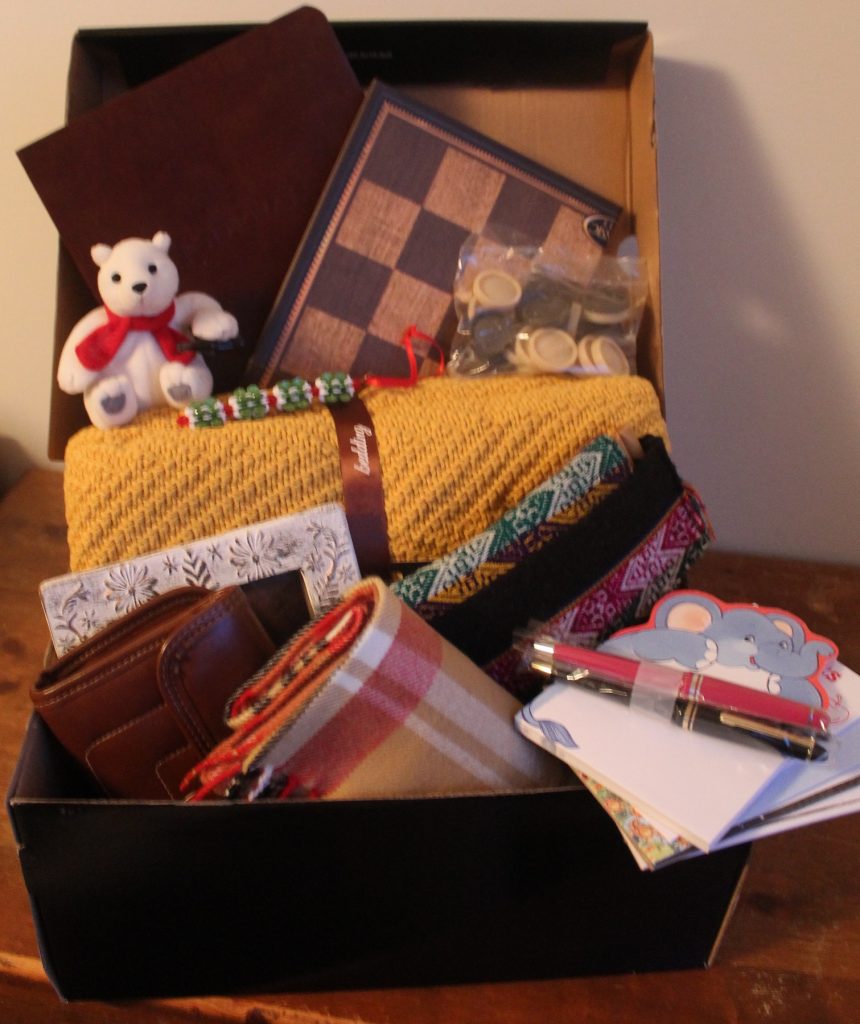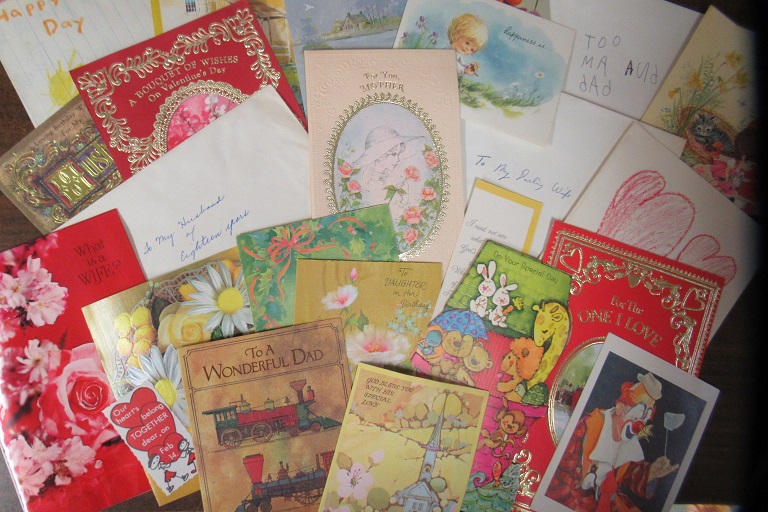
“God’s Box” Photo copyright (c) 2021 V.P.B. |
An excellent hands-on outreach project that you can do with your children this time of year is packing a shoebox together for Operation Christmas Child. Each shoebox you pack and drop off with OCC will be given out with the Gospel, impacting not only the child who receives it but also potentially reaching that child’s family and community with the good news of Jesus Christ as well. |
If you’ve never packed a shoebox before, here’s a brief “how-to.”
- Find a standard-size adult shoebox and wrap it if you like – cover must be wrapped separately from the box so items inside can be inspected. (You can also use pre-printed boxes from Samaritan’s Purse or plastic shoeboxes from the store.)
- Choose a “wow item” to go in the box – something a child would be excited to receive such as a doll for a little girl or a soccer ball and hand pump for a little boy or a stuffed animal for either.
- Fill the rest of the box with smaller items – hygiene items like toothbrush, deodorant, soap and washcloth or school supplies like pencils and a sharpener, crayons, scissors, and a calculator. You can also put in additional toys – maybe a jump rope, flashlight, little cars, games, etc. If you enjoy handcrafting items, get creative and make something special! Clothing items can be great to include, too, such as tee-shirts, socks, flip-flops, or underwear.
- Remember not to put anything in the box that’s not allowed by OCC. For example: war items, liquids, toothpaste, medicines, or candy. You can find a list of prohibited items on the OCC website along with examples of many, many more things that you are allowed to include.
- Write a personal letter to the child and consider enclosing a photo of your family. Attach a label to the outside of the box, indicating the age and gender of the child to receive the gift. You can print a label from this page.
- Take the shoebox along with a donation of $9.00 (covers shipping the box across the world) to a local church during collection week. If you need help finding a church that’s collecting shoeboxes for OCC, check here. Last but not least — don’t forget to pray for the child who will receive the box you and your family put together!
That’s it! It’s very simple but incredibly rewarding, and I love that each box is a reflection of the child or family who packed it. It’s an opportunity to reach across time and space and touch the life of a child you would likely never have met in person. After collection week, your box will be delivered to a processing center here in the States to be checked over and then it’s on its way to one of over a hundred different countries in the world for distribution. Shoeboxes are handed out by volunteers in local churches overseas, and in many countries, children receiving a shoebox also have the opportunity to enroll in The Greatest Journey, a twelve-week Christian discipleship course.
If you’re concerned about the amount it will cost to pack a box or multiple boxes all at once, try spreading the project out through the year. Purchase a couple items each month rather than trying to buy them all at one time. Look for sale items and be aware of “extras” that might come through your hands. When we ordered socks recently for our daughters, we ended up with packages that were a substitution for our original choice, but the substituted packs included bonus pairs! Things like that can go in a shoebox at no cost at all. Also recently, a lady at our church put some items on a table at the back for anyone to take that could use them. After I made sure others had had a chance to look over things, I picked out a brand-new, small piece of pretty wall art that was left behind. It will be the start to a shoebox for a teen girl next year! And one of my girls found a child’s sweatshirt (also new) among the items, which she’ll use to start filling a shoebox of her own.
Here’s a testimony that I recently submitted to Samaritan’s Purse when they reached out to local project leaders for feedback:
Because we do encourage others to pack shoeboxes, we wanted to make sure it was something someone could do even if they didn’t have much money. So, we prayed at the beginning of the year* for God to pack a box for us to show us that it could be done for literally nothing. We even prayed for the $9.00 to ship it. Then we waited — God answered our prayer in the affirmative! We now have a big shoebox entirely full of brand-new things that God sent in over the next few months, from little things like stationery and pens right up to and including a heavy, colorful blanket for a wow item!
We had no idea how God would send us a wow item for free, but we knew that God can do anything! Only a few weeks after our prayer, my husband received an offer at his workplace for us to pick a free Christmas present on a special website. We both looked at one another and smiled — we knew who the present was really for. We had so much fun looking through the list of items and choosing that blanket for a child we will never meet this side of Heaven. And when some unexpected dollars came in, we set it aside until we had the nine dollars we had prayed for.
We call it “God’s box,” and we know that He has a special child in mind to receive it. We have a small family business that does a newsletter each month, and we’re writing about “God’s box” this month to encourage those who think they can’t afford to pack a shoebox that if it’s in their heart to share the Gospel with a child, God can make a way. It was also a faith booster for our own children to see how God put that box together. We love the shoebox program precisely because it allows us to be the hands and feet of Christ in spreading the Gospel to other nations. Thank you for allowing us to be involved.
If you’re reading this and you’ve never packed a shoebox before, consider packing one this year and blessing a child with the opportunity to learn about the “reason for the season” – JESUS.
Every good gift and every perfect gift is from above, and cometh down from the Father of lights . . . James 1:17a
![]()
Copyright © 2021
* Timeline note: I should have been more clear here when I wrote this testimony – “the beginning of the year” was actually right after collection week happened last year, so this refers to the starting over of the “shoebox year,” not the calendar year – thus the reference only a short time later to Christmas.


















